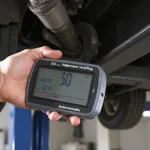More and more drivers are opting for the convenience of an automatic transmission. However, the world of automated gear changes offers more than just one option. Terms like “S tronic” and “Tiptronic” often cause confusion. What exactly is behind these terms and how do they differ? This article sheds light on the matter and helps you make the right choice for your needs.
What is S tronic?
“S tronic” is Audi’s name for their dual-clutch transmission. Unlike conventional automatic transmissions with torque converters, the S tronic works with two sub-transmissions and two clutches. Simply put, one gear is always engaged, while the second clutch is already preparing the next gear. This enables lightning-fast gear changes without interruption of traction, resulting in a more dynamic driving experience and higher fuel efficiency.
“The S tronic offers an unparalleled driving experience,” says Dr. Ing. Helmut Schmidt, former chief engineer for transmission development at Audi. “The combination of comfort and sportiness is unique.”
What is Tiptronic?
“Tiptronic,” on the other hand, refers to a conventional automatic transmission with a torque converter, which was initially used by Porsche and later by other brands of the Volkswagen Group. The special feature of Tiptronic is the option to shift manually. The driver can change gears themselves using paddle shifters on the steering wheel or by tapping the gear selector lever.
In contrast to the S tronic, gear changes in the Tiptronic are not as fast and there is a brief interruption in power delivery. Nevertheless, the Tiptronic offers a comfortable driving experience and the ability to actively intervene in the shifting process.
S tronic vs. Tiptronic: Pros and Cons
Both S tronic and Tiptronic offer advantages and have their specific areas of application.
Advantages of S tronic:
- Faster gear changes: The S tronic enables lightning-fast gear changes without noticeable interruption of traction.
- Higher fuel efficiency: Due to the direct power transmission and optimized shifting strategy, fuel consumption can be reduced.
- Sportier driving experience: The dynamic gear changes contribute to a more agile driving feel.
Disadvantages of S tronic:
- Higher purchase costs: Dual-clutch transmissions are generally more expensive than conventional automatic transmissions.
- More complex technology: The complex design of the S tronic can lead to higher repair costs.
Advantages of Tiptronic:
- More comfortable driving: The Tiptronic ensures smooth gear changes and a relaxed driving experience.
- Manual shift intervention: The driver can take control of gear selection at any time.
- Lower purchase costs: Tiptronic transmissions are generally less expensive than dual-clutch transmissions.
Disadvantages of Tiptronic:
- Slower gear changes: Compared to the S tronic, gear changes are slower and with a brief interruption in power delivery.
- Lower fuel efficiency: Due to the use of the torque converter, fuel consumption is higher compared to the S tronic.
- Less sporty driving experience: While the Tiptronic offers the option of manual gear selection, the gear changes are not as dynamic as with the S tronic.
Conclusion: Which type of transmission is right for you?
The choice between S tronic and Tiptronic ultimately depends on your individual needs and preferences.
If you want a sporty driving experience with maximum performance and value the fastest possible gear changes, then the S tronic is the right choice. It is ideal for drivers who frequently travel on winding country roads or on the highway and want to fully exploit the dynamic driving characteristics of their vehicle.
If, on the other hand, you are looking for a comfortable driving experience with the option of manual intervention, then the Tiptronic is a good option. It is particularly suitable for drivers who drive a lot in city traffic or on long journeys and value relaxed driving.
Frequently Asked Questions about S tronic and Tiptronic:
- What is the difference between S tronic and DSG? DSG (Direct Shift Gearbox) is Volkswagen’s designation for dual-clutch transmissions. S tronic is basically the same transmission, but is used by Audi.
- Can you also shift manually with the S tronic? Yes, the S tronic also offers the option of manual gear selection via paddle shifters on the steering wheel or by tapping the gear selector lever.
- Which transmission is more economical? The S tronic is generally more fuel-efficient than the Tiptronic.
- Which transmission is more expensive to repair? Dual-clutch transmissions like the S tronic are generally more expensive to repair than conventional automatic transmissions.
For more information on the different types of transmissions, see also our article: What is S tronic at Audi?
In addition to S tronic and Tiptronic, there are other interesting types of transmissions. Learn more about Automatic Meaning and discover the variety of automated gear changes.
Do you need further information or have questions about your vehicle? Contact our experts! We will be happy to help you.
